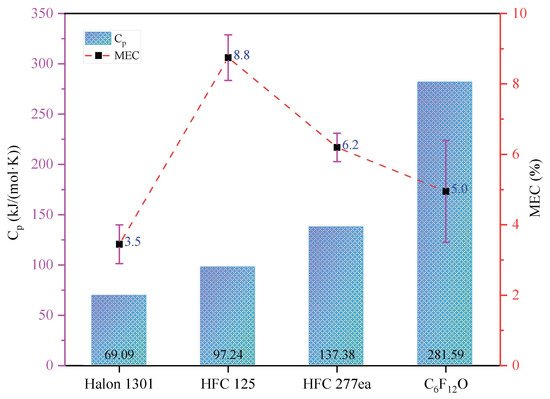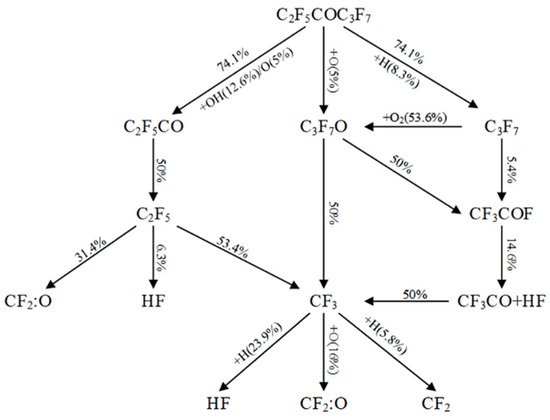The fire extinguishing efficiency of C6F12O has been fully investigated in both a laboratory burner scale and full-scale fire extinguishing experiment, the results of which show that the minimum extinguishing volume concentration of C6F12O is lower than HFCs, but the mass concentration is much higher. Although C6F12O has shown satisfactory fire extinguishing performance in various fire protection scenarios, fire enhancement phenomenon and the large production of HF have been observed during fire extinguishment. Furthermore, the fire extinguishing mechanism of C6F12O has been discussed. The flame suppression effect of C6F12O, combustion enhancement phenomenon and the influence of water in the reaction zone have been revealed.
- C6F12O
- Novec 1230
- Fire Extinguishing Efficiency
- Fire extinguishing mechanism
- combustion enhancement
- Influence of H2O
1. Extinguishing Efficiency
1.1. Laboratory Scale Experiments
| Researcher | Fuel | Test Result of MEC | Note |
|---|---|---|---|
| Carnazza et al. [4] | n-heptane, alcohol and other liquid fuels | n-heptane 4.5%, alcohol 5.6% | |
| Andersson et al. [5][6] | propane | 6.4% | lower than HFC 125 and HFC 227ea under the same experimental conditions, higher than Halon 1301 |
| Rivers et al. [7] | propane | 3.5% | lower than Halon 1301 and Halon 1211 under the same experimental conditions but the required mass for the same fire extinguishing efficiency is relatively high |
| Takahashi et al. [8] | propane | 4.17% | the calculated MEC is 4.12% |
| Li [3] | n-heptane | 4.5–5% | under different gasification heating temperature, air temperature, heating coil and environment temperature |
1.2. Full-Scale Experiment
| Researcher | Aim | Fire Scene | Result |
|---|---|---|---|
| Hodges et al. [21] | Evaluate the fire extinguishing efficiency of C6F12O and the generation amount of acid gas in specific scenarios | Military vehicle, 7.36 m2 chamber | The fire extinguishing efficiency of C6F12O is similar to that of halon and its substitutes, which can extinguish 7.36 m2 fire within 200 ms. However, the mass of fire extinguishing agent and the amount of acid gas in products cannot meet the application standard. |
| Bengtson et al. [22] | Fire extinguishing efficiency and re-burning of C6F12O in polymer fire ignited by different electric power | Polymer fire ignited by 192W electric power | The fire extinguishing concentration is less than Halon 1301 and higher than the n-heptane test result given by NFPA 2001. When the fire suppressant concentration is higher than the test value of cup burner, the fire can be prevented from re-ignition. |
| Kim et al. [23] | The fire extinguishing efficiency and acid gas generation of C6F12O | 3 kW cable fire, small oil pool and wood stack fire under the design concentration (6.5%) in 58 m3 space | It takes a long time for the extinguishing agent to reach the extinguishing concentration in the confined space. The cable fire is put out 72 s after combustion, while it is put out in 30 s in the open and ventilated environment. The wood stack and oil pool fire can be put out in 10 s. A large amount of acid gas is produced in a large flame. |
| Liu et al. [24] | Fire extinguishing efficiency of C6F12O for lithium batteries | 38 Ah prismatic ternary (Li(Ni1/3Co1/3Mn1/3)O2/graphite))battery with the voltage of 4.2 V in 47.5 * 21.5 * 16 cm3 module box | With the increase in agent concentration, the fire extinguishing effect first decreases and then increases. No obvious cooling effect of C6F12O was found in the experiment |
| FAA et al. [25] | Feasibility of fire extinguishing application of C6F12O in aviation application | Jet A fuel in the inclined-plane fire tests,16- and 30-ft pan tests and the simulated engine nacelle fire tests | It is similar to halotron I (CF3CHCl2/Ar/CF4 mixture), but the volume and mass of C6F12O are larger than halotron I |
2. Fire Extinguishing Mechanism
2.1. Physical Mechanism

2.2. Chemical Mechanism
Chemical Extinguishing Process of C6F12O

Influence of H Content in Reaction Environment on Fire Extinguishing Process
Flame Enhancement Mechanism during the Fire Extinguishment
This entry is adapted from the peer-reviewed paper 10.3390/fire5020050
References
- Hirst, R.; Booth, K. Measurement of flame-extinguishing concentrations. Fire Technol. 1977, 13, 296–315.
- Takahashi, F.; Linteris, G.T.; Katta, V.R. Suppression of cup-burner flames. In Proceedings of the Fourth International Symposium on Scale Modeling (ISSM-IV), Cleveland, OH, USA, 17–19 September 2003.
- Li, S. Study on the Measurement of Perfluorohexanone Extinguishing Concentration; Nanjing University of Science and Technology: Nanjing, China, 2018.
- Carnazza, B.; Owens, J.; Rivers, P.; Schmeer, J. FK-5-1-12 Performance Characteristics: Recent Developments, NIST SP 984-2. In Proceedings of the 14th Halon Options Technical Working Conference (HOTWC), Next Generation Fire Suppression Technology Program, Albuquerque, NM, USA, 4–6 May 2004; Available online: https://www.nist.gov/system/files/documents/el/fire_research/R0401178.pdf (accessed on 5 April 2022).
- Andersson, B.; Blomqvist, P. Experimental study of thermal breakdown products from halogenated extinguishing agents. Fire Saf. J. 2011, 46, 104–115.
- Andersson, B.; Blomqvist, P.; Dederichs, A. Thermal Breakdown of Extinguishing Agents; LUTVDG/TVBB-3137-SE; Department of Fire Safety Engineering and Systems Safety, Lund University: Lund, Sweden, 2008.
- Rivers, P.E. Advancement in Sustainable Fire Suppression Development C, F-Ketone: A Novel New Halon Replacement Alternative to HFCs and PFCs. In Proceedings of the 2001 Halon Options Technical Working Conference, Albuquerque, NM, USA, 24–26 April 2001.
- Takahashi, F.; VKatta, R.; Babushok, V.I.; Linteris, G.T. Numerical and experimental studies of extinguishment of cup-burner flames by C6F12O. Proc. Combust. Inst. 2021, 38, 4645–4653.
- Saso, Y.; Saito, N.; Iwata, Y. Scale effect of cup burner on flame-extinguishing concentrations. Fire Technol. 1993, 29, 22–33.
- Holmstedt, G.; Andersson, P.; Andersson, J. Investigation of Scale Effects on Halon and Halon Alternatives Regarding Flame Extinguishing, Lnerting Concerntration and Thermal Decomposition Products. Fire Saf. Sci. 1994, 4, 853–864.
- McCaffrey, B.J. Jet Diffusion Flame Suppression Using Water Sprays—An Interim Report. Combust. Sci. Technol. 1984, 40, 107–136.
- Andersson, J. Halotron: A Total Concept Halon Replacement; 1988. Available online: https://www.nist.gov/system/files/documents/el/fire_research/R0301004.pdf (accessed on 5 April 2022).
- Pitts, W.M.; Yang, J.C.; Huber, M.L.; Blevins, L.G. Characterization and Identification of Super-Effective Thermal Fire Extinguishing Agents; US Department of Commerce, National Institute of Standards and Technology: Gaithersburg, MD, USA, 1999.
- Yang, J.C.; Donnelly, M.K.; Prive, M.; Grosshandler, W.L. Fire Suppression Efficiency Screening Using a Counterflow Cylindrical Burner; National Inst of Standards and Technology Gaithersburg Md Building and Fire: Gaithersburg, MD, USA, 1999.
- Yang, J.C.; Donnelly, M.K.; Prive, N.C.; Grosshandler, W.L. An apparatus for screening fire suppression efficiency of dispersed liquid agents. Fire Saf. J. 2001, 36, 55–72.
- Yang, J.C.; Pitts, W.M.; Huber, M.L. Enhanced Effectiveness of Liquid Thermal Fire Extinguishing Agents. Fire Saf. Sci. 2008, 9, 579–589.
- Reinhardt, J.W. Behavior of Bromotrifluoropropene and Pentafluoroethane When Subjected to a Simulated Aerosol Can Explosion; US Department of Transportation, Federal Aviation Administration: Washington, DC, USA, 2004.
- Reinhardt, J.W. Minimum Performance Standard for Aircraft Cargo Compartment Halon Replacement Fire Suppression Systems (2012 Update); U.S. Department of Transportation, Federal Aviation Administration: Washington, DC, USA, 2012.
- Reinhardt, J. Aircraft Cargo MPS Test of FK-5-1-12; International Aircraft Systems Fire Protection Working Group: Atlantic City, NJ, USA, 2006; pp. 25–26.
- Ditch, B.D. Thermal Decomposition Products Testing With 1,1,1,2,2,4,5,5,5 nonafluoro-4-trifluoromethyl pentan-3-one (C6 F-ketone) during Fire Extinguishing. Master’s Thesis, Worcester Polytechnic University, Worcester, MA, USA, 2003.
- Hodges, S.E.; McCormick, S.J. Fire Extinguishing Agents for Protection of Occupied Spaces in Military Ground Vehicles. Fire Technol. 2013, 49, 379–394.
- Bengtson, G.; Niemann, R.; Lenexa, K. Update in the evaluation of selected NFPA 2001 agents for suppressing class “C” energized fires. Pap. From 2001, 984. Available online: https://www.nist.gov/system/files/documents/el/fire_research/R0501593.pdf (accessed on 5 April 2022).
- Kim, A.; Crampton, G.; Kanabus-Kaminska, M. Performance of Novec1230 in Electronic Facility Fire Protection; NRCC-53526; National Research Council Canada: Montreal, QC, Canada, 2010.
- Liu, Y.; Duan, Q.; Xu, J.; Chen, H.; Lu, W.; Wang, Q. Experimental study on the efficiency of dodecafluoro-2-methylpentan-3-one on suppressing lithium-ion battery fires. RSC Adv. 2018, 8, 42223–42232.
- Administration, F.A. Full-Scale Evaluation of NovecTM1230; National Technical Information Services (NIST): Springfield, IL, USA, 2019.
- 3M Company. 3MTM Novec1230TM Fire Protection Fluid; 3M Company: Saint Paul, MN, USA, 2020.
- Linteris, G.T.; Babushok, V.I.; Sunderland, P.B.; Takahashi, F.; Katta, V.R.; Meier, O. Unwanted combustion enhancement by C6F12O fire suppressant. Proc. Combust. Inst. 2013, 34, 2683–2690.
- Xu, W.; Jiang, Y.; Ren, X. Combustion promotion and extinction of premixed counterflow methane/air flames by C6F12O fire suppressant. J. Fire Sci. 2016, 34, 289–304.
- Pagliaro, J.L.; Linteris, G.T.; Sunderland, P.B.; Baker, P.T. Combustion inhibition and enhancement of premixed methane-air flames by halon replacements. Combust. Flame 2015, 162, 41–49.
- Babushok, V.I.; Linteris, G.T.; Meier, O.C. Combustion properties of halogenated fire suppressants. Combust. Flame 2012, 159, 3569–3575.
- Pagliaro, J.L.; Linteris, G.T. Hydrocarbon flame inhibition by C6F12O (Novec 1230): Unstretched burning velocity measurements and predictions. Fire Saf. J. 2017, 87, 10–17.
- Liu, L.; Du, Z.; Zhang, T.; Guo, Z.; He, M.; Liu, Z. The inhibition/promotion effect of C6F12O added to a lithium-ion cell syngas premixed flame. Int. J. Hydrogen Energy 2019, 44, 22282–22300.
- Linteris, G.T.; Takahashi, F.; Katta, V.R.; Chelliah, H.; Meier, O. Thermodynamic analysis of suppressant-enhanced overpressure in the FAA aerosol can simulator. Fire Saf. Sci. 2011, 10, 307–320.
- Linteris, G.T.; Burgess, D.R.; Takahashi, F.; Katta, V.R.; Chelliah, H.K.; Meier, O. Stirred reactor calculations to understand unwanted combustion enhancement by potential halon replacements. Combust. Flame 2012, 159, 1016–1025.
- Ke, W.; Yang, W.; Zhou, B.; Wang, K.; Sun, J.; Sun, X.; Xu, M.; Chen, Q.; Qiu, B.; Wang, W.; et al. The color change analysis of historic wooden remains after fire-suppression by fluorinated chemical gases. Herit. Sci. 2021, 9, 93.
- Wang, X.; Wu, R.; Cheng, L.; Zhang, X.; Zhou, X. Suppression of propane cup-burner flame with HFO-1336mzz(Z) and its thermal stability study. Thermochim. Acta 2020, 683, 178463.
- Ren, X.; Jiang, Y.; Xu, W. Numerical investigation of the chemical and physical effects of halogenated fire suppressants addition on methane-air mixtures. J. Fire Sci. 2016, 34, 416–430.
- Xing, H.; Cheng, Y.; Lu, S.; Tao, N.; Zhang, H. A reactive molecular dynamics study of the pyrolysis mechanism of C6F12O. Mol. Phys. 2021, 119, e1976425.
